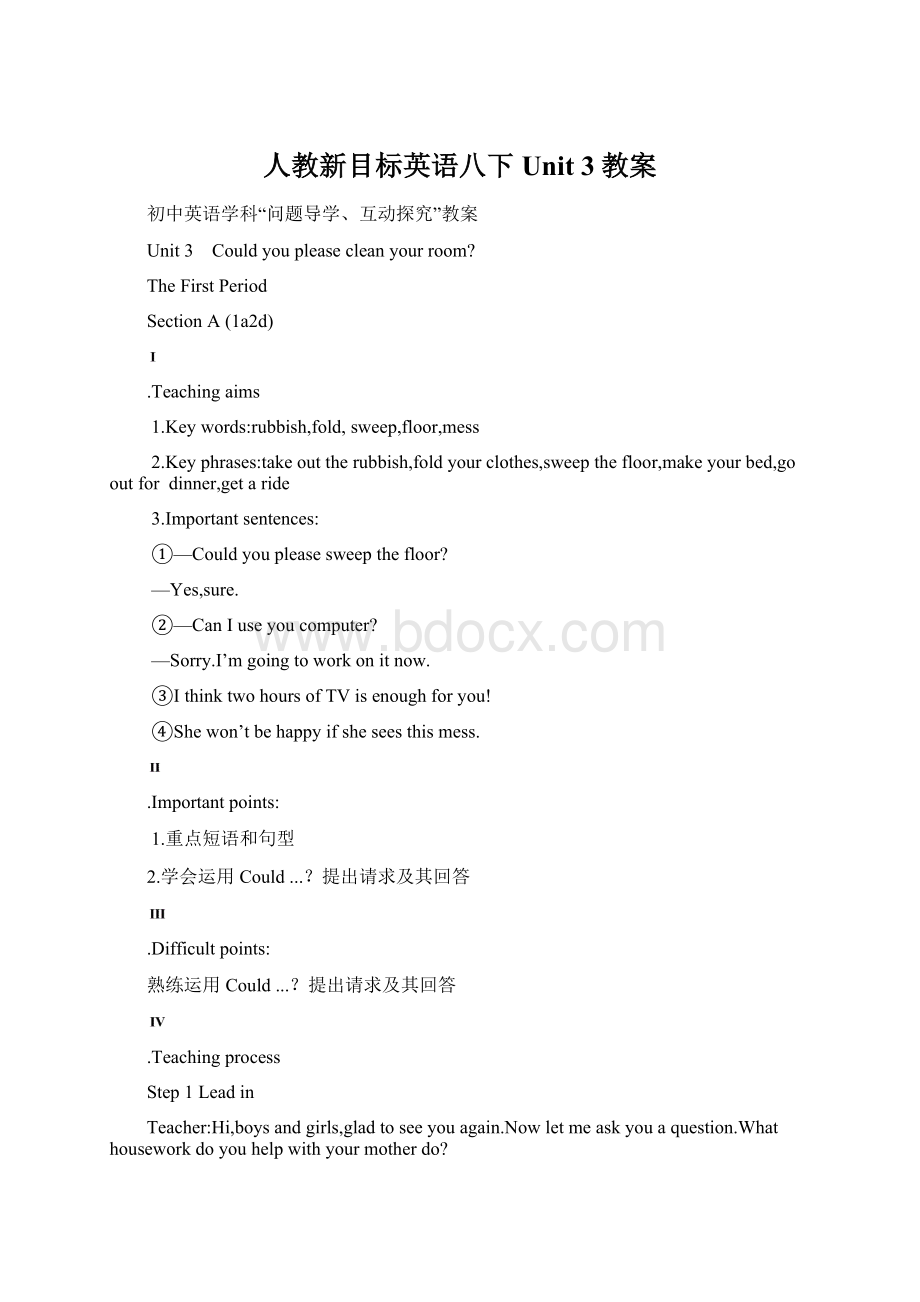 人教新目标英语八下Unit 3教案Word格式.docx
人教新目标英语八下Unit 3教案Word格式.docx
- 文档编号:20426508
- 上传时间:2023-01-22
- 格式:DOCX
- 页数:17
- 大小:31.51KB
人教新目标英语八下Unit 3教案Word格式.docx
《人教新目标英语八下Unit 3教案Word格式.docx》由会员分享,可在线阅读,更多相关《人教新目标英语八下Unit 3教案Word格式.docx(17页珍藏版)》请在冰豆网上搜索。

Hi,boysandgirls,gladtoseeyouagain.Nowletmeaskyouaquestion.Whathouseworkdoyouhelpwithyourmotherdo?
Student1:
Icleanthebedroom.
Student2:
Idothedishes.
Student3:
Ihelpmymotherwashclothes.
...
Verygood.Weareoldenoughtohelpourparentsdosomehousework.Infact,wecandomuchhousework,butwecan’texpresstheminEnglish.Don’tworry.Todaywewilllearnmorephrasesabouthousework.Nowpleaselookatthepictures.WewilllearnhowtoexpresstheminEnglish.
Thenteachthestudentsnewwordsandnewphrases.
Step2Workon1a 1c
1.学生朗读1a中的短语,教师纠正错误读音,然后学生识记单词,两人一组互相提问。
2.仿照参考案例的形式两人一组互相询问对方是否做这些家务。
A:
Doyoudothedishes?
B:
Yes,Ioftendothedishes.Whataboutyou?
Idoittwiceaweek.
3.学生齐读1b中的短语,为听力做好准备。
4.听录音,标注出Peter和他妈妈做的家务,并集体核对答案。
5.再听一遍录音,并跟读对话。
6.分组练习1c中的对话,并请一些学生表演出他们的对话。
7.模仿1c中的对话,用1a中的短语与同伴编新对话,并邀请几组学生表演对话。
Couldyoupleasesweepthefloor?
Yes,sure.Canyoudothedishes?
Well,couldyoupleasedothem?
I’mgoingtocleanthelivingroom.
Noproblem.
Step3Workon2a 2c
1.大声朗读2a中的短语和句子。
听录音,判断Peter能否做这些事情,分别在Yes或No后面标出来。
集体核对答案。
2.再听一遍录音,将Peter不能做的事情的原因用横线标出来。
完成后集体核对答案。
3.听第三遍录音,学生跟读。
4.让学生利用2a中的信息仿照2c的形式练习对话,并请多组同学表演对话。
CouldIuseyourcomputer?
Sorry.I’mgoingtoworkonitnow.
Well,couldIwatchTV?
Yes,youcan,butfirstyouhavetocleanyourroom.
Step4Workon2d
1.学生自己读对话,回答下面的问题。
①Whatistheboydoing?
②Whatistheboy’smotherdoing?
③Whatdoesthesisterwanttheboytodo?
2.让学生大声朗读2d中的对话,读熟后与同伴结对练习,分角色表演对话。
3.邀请三组学生来表演对话。
Languagepoints
1.Couldyoupleasehelpmesweepthefloor?
你可以帮我扫地吗?
(教材第17页)
表示请求对方做某事可以用Couldyouplease...?
其肯定回答为Yes,sure./Ofcourse.或Yes,mypleasure.等;
否定回答可用Sorry,Ican’t.或Sorry,I’mafraidnot.Ihaveto...等。
这种句型的否定结构是在please后加not。
e.g.:
Couldyoupleasenotstandhere?
你可以不站在这儿吗?
2.CouldIuseyourcomputer?
我能用你的电脑吗?
(教材第18页)
CouldI/we...?
表示请求得到对方的允许,意思是“我/我们可以……吗?
”这种问句无论是肯定回答还是否定回答都避免用could。
肯定回答常用Yes,youcan...,否定回答常用Sorry/No,youcan’t。
Exercise
1、单项选择。
1.—Couldyouplease________therubbishwhenyougoout?
—Certainly,Mom.
A.takeinB.putout
C.takeoutD.lookout
2.Idon’tlikedoingthedishesbecauseit’s________.
A.interestingB.bored
C.interestedD.boring
3.—Mycarhasbrokendown.Couldyoupleasegivemearidetomorrow?
—I’msorry.I________.I’mleavingforLondontonight.
A.can’tB.mustn’t
C.couldn’tD.shouldn’t
4.—Manuel,haveyoufinishedyourwork?
—Sorry.I’mgoingto________itnow.
A.workinB.workon
C.workatD.workover
二、根据句意用所给词的适当形式填空。
1.Couldyouplease______(open)thedoor,Nick?
2.Mary’smotheroftencleansthe______(live)roominthemorning.
3.It’stoolate.Ihaveto______(go)toworkbytaxi.
4.Mysisteroftendoesthe______(dish)aftermeals.
Homework
Memorizethenewwordsandphrasesbyheart.
板书设计
—Couldyoupleasesweepthefloor?
—CanIuseyoucomputer?
IthinktwohoursofTVisenoughforyou!
Shewon’tbehappyifsheseesthismess.
教学反思:
TheSecondPeriod
SectionA(3a 3c)
I.Teachingaims
throw,neither,shirt
beangrywith,comehomefromschool,comeover,throwdown,allthetime,allday,insurprise,assoonas
①TheminuteIsatdowninfrontoftheTV,mymomcameover.
②Couldyoupleasetakethedogforawalk?
③YouwatchTVallthetimeandneverhelpoutaroundthehouse.
④ShedidnotdoanyhouseworkandneitherdidI.
⑤Ifinallyunderstandthatweneedtosharethehouseworktohaveacleanandcomfortablehome.
⑥Neitherofusdidanyhouseworkforaweek.
II.Importantpoints:
1.重点短语及句型
2.不同词性的同一单词的不同用法
III.Difficultpoints:
IV.Teachingprocess
Doyouoftenhelpyourparentsdothehousework?
Wasyourparentsangryifyoudon’tdothehousework?
Ifeveryoneinyourfamilydoesn’tdothehousework,whatwillhappen?
TodaywewillreadastoryaboutNancyandhermother.Let’sreadthestoryandseewhathappenedtoNancyandhermother.
Step2Workon3a 3b
1.阅读3a短文,根据短文内容,回答问题:
WhywasNancy’smotherangrywithNancy?
Didtheysolvetheproblem?
How?
2.朗读3b中的句子,然后认真阅读短文,标注出3b中句子的同义句,完成后让学生展示自己的答案,教师点拨。
3.再次细心阅读短文,理解每一句话的意思,小组合作解决遇到的疑难问题。
4.教师点拨短文中出现的重点和难点。
5.熟读短文,识记背诵知识要点。
Step3Workon3c
1.认真阅读3c中的句子,判断画线单词在句子中的词性是动词还是名词,完成后集体核对答案。
2.然后用单词的另外一个词性来造句,让几个学生到黑板上写下句子,教师点评所写句子。
3.小组内互相交流所写的句子。
1.neither的用法
(1)neither用作形容词时只能与单数名词连用,谓语动词也用单数形式,意为“没有一个”。
neither用作代词时,意为“两者都不”,其用作主语时,谓语动词用单数形式。
(2)neither...nor...连接主语时,谓语动词必须与nor后面的名词或代词在人称及数上保持一致,即所谓的就近原则。
意为“既不……,也不……”,与both...and...所表达的含义相对。
(3)neither用作副词,作“也不”解释,放在句首,表示前面否定的内容也适用于另一个人或物,句子须采用部分倒装,即“Neither+助动词+主语”这个结构,此时也可用nor替换neither使用。
使用时,时态与上句要保持一致,助动词的数应与其后面的主语保持一致。
2.assoonas的用法
assoonas连接的时间状语从句中,指未发生的动作,规律是:
主句用一般将来时态,从句用一般现在时态代替一般将来时;
指紧接着发生的两个短动作,主从句都用一般过去时态。
单项选择。
1.Theboywaslateagain,histeacherwasveryangry________him.
A.to B.for C.at D.with
2.Ifyoudon’tfoldyourclothes,________.Youshoulddoitbyyourself.
A.sodoIB.soIdoC.neitherdoID.neitherwillI
3.Ihavetwobrothers,butneitherof________goingshopping.
A.themlikeB.himlikes
C.theylikesD.themlikes
4.JackwenttoBeijingjustnow.Hewillcallyouupassoonashe________there.
A.willarriveB.arrivesin
C.arrivesD.arrive
5.Johnturnedaroundandlookedatme________.
A.insurprisedB.insurprisingly
C.insurpriseD.tomysurprise
6.IleftmyEnglishbookathome.Couldyoupleaseshareyours________me?
A.toB.forC.atD.with
Readthepassagein3aandrememberimportantwordsaswellasphrases.
SectionA(3a 3c)
beangrywithcomeoverinsurpriseassoonas
TheminuteIsatdowninfrontoftheTV,mymomcameover.
Ifinallyunderstandthatweneedtosharethehouseworktohaveacleanandcomfortablehome.
TheThirdPeriod
SectionA(GrammarFocus 4c)
pass,borrow,lend,finger,hate,while
hangout,dochores
①Couldwegetsomethingtodrinkafterthemovie?
②CouldIhangoutwithmyfriendsafterthemovie?
③Couldyoupleasepassmethesalt?
④CouldIborrowthatbook?
⑤Couldyoulendmesomemoney?
⑥IcutmyfingerandI’mtryingnottogetitwet.
1.重点单词和短语
2.会用could有礼貌地来表达请求做某事及其应答语
Couldyoupleasetakeouttherubbish?
Couldyoupleasegotothemoviewithme?
Sorry,Ican’t.Ihavetodomyhomework.
Nowpleaseaskandanswerlikethisinpairswiththephrasesinthisunittoreviewwhatwehavelearned.
Step2WorkonGrammarFocus
学生大声朗读GrammarFocus的句子。
Step3Workon4a 4c
1.认真阅读4a中的句子,在表示请求的句子前写R,在表示许可的句子前写P,然后将两组句子匹配,完成后集体核对答案,然后两人一组大声朗读对话。
2.结合例句,小组内由学生总结单词pass,borrow和lend的用法,教师点拨解析。
3.阅读4b中的对话,根据所学的知识完成填空,集体核对答案。
然后两人一组大声朗读对话。
4.小组内列一个野营需要的物品清单,然后以4c对话形式讨论谁将准备这些东西,并且完成4c的表格。
Couldyoupleasebringatent,LiuChang?
Sure.Andcouldyouplease...?
C:
Sorry,Ican’t.Ihaveto...
1.borrow和lend的用法
从基本词义上看:
两者都可表示“借”,但是borrow指“借进”,而lend则指“借出”,两者其实是一对反义词,而不是同义词。
从句型搭配上看:
要表示“向某人借某物”,英语用borrow,其中要用介词from;
要表示“把某物借给某人”,英语用lend,其中要用介词to。
从是否接双宾语来看:
lend可接双宾语(即可用于lendsb.sth.),但borrow则不能接双宾语(即不能用于borrowsb.sth.)。
2.pass的用法
pass意为“递”,后面可以跟双宾语,经常用到的句型“把某物传递给某人”passsb.sth.或者是passsth.tosb.,但是当直接宾语为代词时只适用句型:
passsth.tosb.。
Exercise
一、单项选择。
1.Excuseme.Couldyoupleasepassthebook________me?
A.to B.for C.with D.of
2.Mymoneyranout,couldI________somemoney________you?
A.borrow;
toB.lend;
from
C.lent;
toD.borrow;
3.Thelittleboyhasasorethroatandhetries______toomuch.
A.nottalkB.nottotalk
C.doesn’ttalkD.totalk
二、汉译英。
1.我能和我的朋友出去吃饭吗?
2.看完电影后我们能买点喝的东西吗?
3.你能带着狗去散步吗?
4.你能倒掉垃圾吗?
RecitethesentencesinGrammarFocus.
SectionA(GrammarFocus 4c)
Couldwegetsomethingtodrinkafterthemovie?
CouldIhangoutwithmyfriendsafterthemovie?
Couldyoupleasepassmethesalt?
CouldIborrowthatbook?
Couldyoulendmesomemoney?
IcutmyfingerandI’mtryingnottogetitwet.
TheFourthPeriod
SectionB(1a 1e)
snack
borrowsomemoney,gotothestore,useyourCDplayer
—CouldIinvitemyfriendstoaparty?
—No,youcan’thaveaparty.YouhaveatestonMonday.
Preparesomecardswithsomephrasesonthem.Onestudentactsaccordingtothephrases,andtheothersguesswhatheisdoing.
Step2Workon1a 1b
1.两人一组互相提问1a中的短语。
2.在生活中青少年会要求父母做一些事情,同
- 配套讲稿:
如PPT文件的首页显示word图标,表示该PPT已包含配套word讲稿。双击word图标可打开word文档。
- 特殊限制:
部分文档作品中含有的国旗、国徽等图片,仅作为作品整体效果示例展示,禁止商用。设计者仅对作品中独创性部分享有著作权。
- 关 键 词:
- 人教新目标英语八下Unit 3教案 新目标 英语 Unit 教案
 冰豆网所有资源均是用户自行上传分享,仅供网友学习交流,未经上传用户书面授权,请勿作他用。
冰豆网所有资源均是用户自行上传分享,仅供网友学习交流,未经上传用户书面授权,请勿作他用。


 对中国城市家庭的教育投资行为的理论和实证研究.docx
对中国城市家庭的教育投资行为的理论和实证研究.docx
